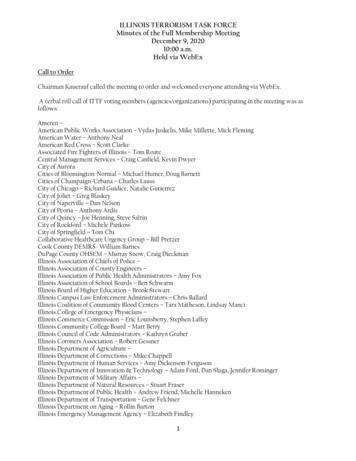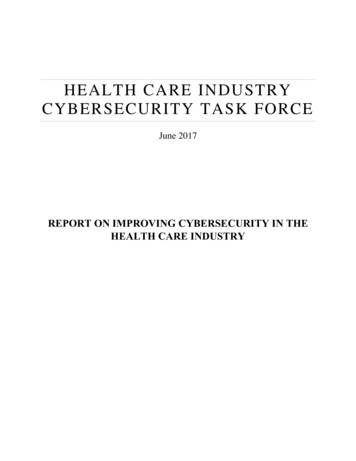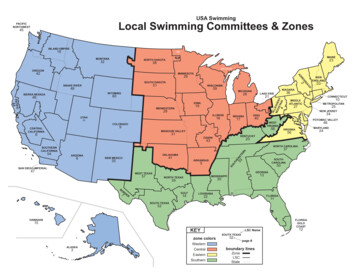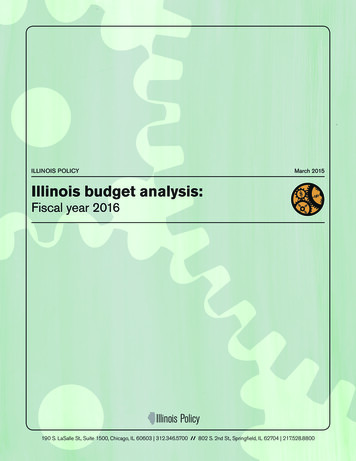
Transcription
Illinois Terrorism Task Force2007 Annual ReportRespectfully Submitted toGovernor Rod R. BlagojevichMarch 1, 2008
Rod R. BlagojevichGovernorAndrew Velasquez IIIInterimHomeland Security Advisor2200 South Dirksen Parkway Springfield, IL 62703-4554 phone: (217) 558-1334 fax: (217) 558-1335www.ready.illinois.govMike Chamness – ChairIllinois Terrorism Task ForceMembersAmerican Public Works Assoc.American Red CrossArcher -Daniels-MidlandAssociated Fire Fighters of ILCentral Management ServicesCities of Bloomington-NormalCities of Champaign-UrbanaCity of AuroraCity of ChicagoCity of JolietCity of NapervilleCity of PeoriaCity of RockfordCity of SpringfieldCook County ESDADepartment of Homeland Security/FEMA-Region VDuPage County OEMFederal Bureau of InvestigationGovernor's OfficeIL Assoc. of Chiefs of PoliceIL Assoc. of Public Health AdministratorsIL Assoc. of School BoardsIL Attorney General's OfficeIL Campus Law Enforcement AdministratorsIL College of Emergency PhysiciansIL Coroners AssociationIL Department of AgricultureIL Department of CorrectionsIL Department of Military AffairsIL Department of Natural ResourcesIL Department of Public HealthIL Department of TransportationIL Education AssociationIL Emergency Management AgencyIL Emergency Services Management Assoc.IL Environmental Protection AgencyIL Firefighters AssociationIL Fire Chiefs AssociationIL Fire Services AssociationIL Fire Service InstituteIL Health Care AssociationIL Law Enforcement Alarm SystemIL Law Enforcement Training & Standards Bd.IL Municipal LeagueIL National Emergency Number AssociationIL Office of the State Fire MarshalIL Public Health Mutual Aid SystemIL Security Chiefs AssociationIL Sheriffs AssociationIL State PoliceIL States Attorneys AssociationKane County ESDALake County ESDAMetro East (St. Clair-Madison)Mutual Aid Box Alarm SystemQuad Cities (Moline-E. Moline-Rock Island)Regional Superintendents of SchoolsSchool Crisis Assistance TeamSecretary of State PoliceState Board of Higher EducationU.S. Attorney's OfficeWill County EMACommitteesBioterrorismChicago/Cook County UASI WorkgroupCommunicationsCrisis Response & PreventionEmergency Management WorkgroupFire Mutual AidInformation TechnologyLaw Enforcement Mutual AidPrivate SectorPublic InformationScience & TechnologyTrainingTransportationVolunteers and DonationsMarch 1, 2008The Honorable Rod R. BlagojevichGovernorState of IllinoisDear Governor Blagojevich,The tragic events on April 16, 2007, on the campus of Virginia Tech University and within ourstate on February 14, 2008, at Northern Illinois University remind us that we need to continueto be vigilant in our efforts to protect our citizens. These efforts include conductingpreparedness activities such as training first responders and school administration and security,developing communication systems that are fully interoperable, and maintaining the nation’smost robust mutual-aid system to ensure first responders and specialized response teams arecapable of quickly responding to major events. It is also critical that we continue to educatethe citizens of Illinois so they are prepared for emergencies, as well as solicit their assistanceby encouraging registration with the Illinois Volunteers program.Included in this report are the accomplishments of the Illinois homeland security program incalendar year 2007. Some of the major initiatives included the completion of the first statewidecommunications interoperability plan that provides a common system for communicatingamong public safety officials during an emergency, creation of the Illinois Campus SecurityTask Force to help college and university security officials prepare for incidents on theircampuses, and establishment of the Ready Illinois website to offer a comprehensive means toeducate individuals on steps they should take before emergencies happen, what to do once adisaster has occurred, and tips for recovery after the event.This report includes an Executive Summary as well as in-depth committee reports detailingmany other 2007 accomplishments and our top priorities for 2008.On behalf of the Illinois Terrorism Task Force (ITTF), I want to thank you for your continuedstrong leadership and support of homeland security initiatives. Your appointment of LouannerPeters as Deputy Governor over public safety agencies and your appointment of AndrewVelasquez III as director of the Illinois Emergency Management Agency and interim HomelandSecurity Advisor have helped strengthen our state’s homeland security program.The ITTF also would like to express its appreciation to Col. Jill Morgenthaler, who recently leftstate government, for her exemplary contributions to homeland security as the IllinoisHomeland Security Advisor and deputy chief of staff for public safety.Finally, I want to thank the members of the ITTF for their dedication, commitment, and tirelessefforts to implement homeland security programs and policies to protect our state’s mostprecious resource, our citizens.Respectfully,Mike Chamness, ChairmanIllinois Terrorism Task Force
Table of ContentsOverview of the Illinois Terrorism Task Force.Page1Executive Summary.2Executive Order Creating Illinois Terrorism Task Force.6Organizational Chart .82007 Membership.9Committee ReportsBioterrorism Committee.Communications Committee .Crisis Response and Prevention Committee .Emergency Management Committee .Fire Mutual Aid Committee .Information Technology Committee .Law Enforcement Mutual Aid Committee.Private Sector Committee.Public Information Committee.Science and Technology Committee .Training Committee .Transportation Committee.Urban Area Committee.Volunteers and Donations/Illinois Citizens Corps Committee .1115172224283237394446535661Revised Illinois Homeland Security Strategy .63Key Illinois Homeland Security ActivitiesReady Illinois Disaster Preparedness Website.Campus Safety Initiatives.7072AppendixIllinois Homeland Security Grant Funds.Homeland Security Region and Team Maps .Glossary of Acronyms .757884
Overview of the Illinois Terrorism Task ForceThe Illinois Terrorism Task Force (ITTF) was formalized by a State of Illinois Executive Order inMay 2000 and established as a permanent entity by Governor Rod Blagojevich’s 2003 ExecutiveOrder. The ITTF serves as an advisory body to the Governor and provides statutoryrecommendations and guidance on homeland security laws, policies, protocol, and procedures.The ITTF also serves as the state homeland security strategic planning and policy body for theU.S. Department of Homeland Security grant programs. Administrative support to the ITTF isprovided through the Illinois Emergency Management Agency.The ITTF is made up of 14 committees: Bioterrorism, Communications, Crisis Response andPrevention, Emergency Management, Fire Mutual Aid, Information Technology, LawEnforcement Mutual Aid, Private Sector, Public Information, Science and Technology, Training,Transportation, Urban Area, and Volunteers and Donations/Illinois Citizens Corps Committee.The task force represents more than 60 agencies, including federal, state, local, private sector,and nongovernmental organizations. The ITTF meets on a monthly basis, and the committeesmeet on a monthly, bi-monthly or "as-needed" basis.The task force continues to establish and maintain long-term strategic solutions to the threatsand realities of terrorism and major events. At the same time, federal, state, and local entities,their private and non-governmental partners, and the general public collaborate to achieve andsustain risk-based target levels of capability to prevent, protect against, respond to, and recoverfrom these incidents in order to minimize the impact on lives, property, and the economy.Annually, the ITTF publishes a report to the Governor outlining key homeland securityaccomplishments and future initiatives. Prior years’ reports can be downloaded from theReady.Illinois.gov web site (www.ready.illinois.gov/ittf).1
Illinois Terrorism Task ForceExecutive SummaryGovernor's Executive Order 2003 (17) created the statewide homeland security advisorycommittee, the Illinois Terrorism Task Force (ITTF). The ITTF is responsible for developing andassisting with the implementation of the state's homeland security strategy as an advisory bodyto the Governor. The ITTF also oversees the management and administration of the U.S.Department of Homeland Security (DHS) Homeland Security Grant Program (HSGP) andInfrastructure Protection Program. The task force continues to build upon a strong foundationof established working partnerships among its 63 members, which represent all public safetyagencies and associations and every community in Illinois.One of the top initiatives of the ITTF continues to be the implementation of a statewidecommunications interoperability platform for voice and data systems. In 2007, the ITTFcontinued to distribute Starcom21 700/800 MHz radios to public safety agencies. To date, morethan 2,800 radios have been distributed. The Starcom21 network is scheduled to have thestate’s final system acceptance from Motorola in early 2008. Another major communicationsinteroperability project completed in 2007 was the deployment of the final IllinoisTelecommunications Emergency Communications System (ITECS) trailer. Each of Illinois’ nineITECS is capable of providing emergency communications to areas impacted by a major event.Through the work of the ITTF Communications Committee and State Interoperability ExecutiveCommittee, Illinois drafted a plan that outlines a system to achieve interoperability of federal,state, and local voice and data systems. Illinois also implemented the Public SafetyInteroperable Communications (PSIC) Grants, which provide funding to help public safetyagencies purchase and deploy communications equipment, as well as develop and implementplans and procedures in the use of interoperable communications systems. A total of 10regional grants totaling nearly 18 million were distributed to jurisdictions in strategic locationsthroughout Illinois. The PSIC grants are part of the 36.4 million Illinois received. The state’sfunding also included 16.2 million allocated for the Chicago/Cook County urban area.The ITTF continued to support the School Security Training Project for public and privateschools. The safe school security training project funded with ITTF grants has met with a highlevel of success. Almost 4,400 educators and first responders have been trained to date. Over750 public school districts out of 889 and over 250 non-public schools out of 1,253 statewidehave sent staff to the training. Illinois also has presented a modified version of the schoolsecurity training program for college campuses in response to the tragic events of Virginia TechUniversity and, most recently, Northern Illinois University. In an effort to strengthenemergency communication on college campuses, Illinois partnered with Motorola, Inc. topurchase more than 300 radios. The radios will provide colleges with the capability to accessthe interoperable communications network used by other responders during emergencies. Also,Illinois created an Illinois Campus Security Task Force with members representing communitycolleges, public and private colleges and universities, proprietary institutions, the ITTF, IEMA,the Illinois State Police, and the Illinois Campus Law Enforcement Administrators. The taskforce will identify training needs and implement programs that will help campus security officialsprepare for, respond to and recover from security incidents on their campuses.The final major initiative in 2007 was the public release of theReady Illinois website (www.Ready.Illinois.gov), which offers22
comprehensive information on steps people can take before emergencies happen, what to doonce a disaster has occurred, and tips for recovery after the event. The Ready Illinois websiteis also a valuable tool for providing up-to-date information to the public during an actualdisaster. A “Current Emergency Information” section can be activated to allow state emergencymanagement officials to post status reports and other public information on the situation,including the location of shelters, road closures and contact information for assistance.Following are some the ITTF’s other top accomplishments for 2007: Continued to be one of the top ranked states in the nation for Strategic NationalStockpile (SNS) preparedness. The Illinois SNS Plan was assessed by Centers for DiseaseControl and Prevention on Sept. 25, 2007, and was scored 91 out of 100. Established a 24-hour-a-day dispatch center for tracking of IMERT resources, equipmentand personnel in cooperation with DuPage County Homeland Security and IDPH. Installed EMnet terminals in fire service agencies throughout the state and initiated aproject to install terminals in some hospitals and public school district offices. Created an Internet Crimes Unit within STIC to take requests not only from lawenforcement officials but also from the general public on incidents involving internetfraud, sexual predators, and suspected intrusion of secure computer networks. Coordinated with DHS for the assignment of a Senior Intelligence Officer to STIC inJanuary 2007, making STIC one of the first state fusion centers to receive thisappointment. Organized a Gaps Analysis Workshop to identify gaps, redundancies, and other issuessurrounding STIC. Individuals from the private sector, fire services, emergencymanagement, public health, and law enforcement participated in this workshop. Delivered Geographic Information Systems (GIS) to every county EMA so that maps canbe made available to first responders arriving at the scene of an incident. Deployed the Groove communication software to local units of government. Currentlymore than 600 of the 850 accounts have been issued. Deployed 17 of the 25 mobile decontamination vehicles through MABAS.Deployed 1,500 radiation detection units to every fire agency in Illinois. The processincluded the deployment and coordination of a standardized field operational protocolwith the state’s nuclear regulatory agency. Acquired a fleet repair and refueling vehiclefor statewide mobilization of fire and EMSunits. The acquisition was identified as aneed from the deployment experiences ofthe Utica Tornado and Hurricane Katrina. Conducted an annual Operational ReadinessExercise for MABAS-Illinois USAR (UrbanSearch and Rescue) Team. The three-daydeployment occurred at IFSI in Champaign.Lessons learned from the event will be usedby MABAS-Illinois to guide future teampreparedness activities.33
Continued to move the Illinois Citizen and Law Enforcement Analysis and ReportingSystem (I-CLEAR) project forward. Partnerships with multiple state and local agenciescontinued to positively influence the quality of public safety and homeland security forthe collection, maintenance, and dissemination of criminal justice data in Illinois. Made significant progress in bringing a secure biometric credential for statewideemergency responders into production. Vendor partners completed the principledevelopment and successfully integrated a photo-processing application capable ofreformatting standard booking photos into a format acceptable for federallyinteroperable credentials. Utilized FY07 Homeland Security grant funds to lease a 122,000 square foot, 13 acre sitefrom Champaign County for use as a regional homeland security training center. Began validation exercises for the 10 Weapons of Mass Destruction Special ResponseTeams (WMD SRT). These multi-jurisdictional and regionally-based teams, eachconsisting of 25-35 experienced SWAT officers, are designed, trained and equipped tooperate in a contaminated area. Created eight Regional Mobile FieldForce teams throughout Illinois. Theseteams consist of 50-70officers/deputies who are speciallytrained to handle civil disturbancesand secure large venues such aspharmaceutical distribution sites andother large events. Initiated the process of purchasingpersonal radiation monitors andtraining state and local police on theuse of these instruments, which represent the state of the art in determining andquantifying radiation sources and risk to device users. Awarded 55 grants to local law enforcement agencies to provide an additional 189mobile data computers to law enforcement agencies with no mobile data capability. Drafted a Memorandum of Understanding, which was accepted by IEMA’s legal counsel,for dealing with private sector assets for the Mutual Aid Response Network (MARN).MARN is a comprehensive initiative that details agreements with the private sector toprovide for the utilization of resources during a critical incident. Received DHS approval on 17 courses developed and submitted by the TrainingCommittee. These courses had been identified in December 2004 in response to theDHS Office of State and Local Government Coordination and Preparedness requirementfor DHS review and approval of a training course in order to qualify for DHS funding. Put 18 Regional Training Centers (RTC) into service. The RTCs had been developedduring 2005-6 in partnership with local communities to support the critical homelandsecurity baseline and on-going team training within the Illinois Homeland SecurityRegions where teams were located. Conducted the first validation for six of the 42 Level A Hazardous Materials ResponseTeams to safely test interoperability and sustainability of the Statewide Response Plan.44
Conducted validation for 10 statewide deployable technical rescue teams representing156 technician-level responders. The validation was conducted over an intensive twoday period and simulated the entire cycle of deployment-initial operations-self sustainedbase camp-redeployment of a major event. For the first time, IMERT deployed and wasfully operational to support the validation teams. Facilitated more than 50 planning workshops throughout Illinois in various homelandsecurity topical areas. Staff continues to develop and seek intelligence sharingworkshops for the Illinois law enforcement community. Installed surveillance equipment on the Chicago Expressways and in the East St. LouisMetro Poplar Street Complex arena. The equipment is used to secure bridges andhighways from unauthorized access to critical infrastructure. City of Chicago continued to expand its wireless (digital data, image, and video)interoperable communications investments through the “Operation Virtual Shield (OVS)”program for fixed video surveillance and detection. Chicago Police Department (CPD) opened its Crime Prevention and Information Center(CPIC), an all-hazards fusion center staffed by local, state and federal partners. TheCPIC integrates real-time data from a wide variety of sources and provides analysts withthe ability to utilize this information to assess risks and mitigation efforts. Announced the Illinois Volunteers program on Sept. 28, 2007, during NationalPreparedness Month. The online database, located at www.ready.illinois.gov/volunteers,is a data clearinghouse of information utilized at the state level on those individuals whohave indicated they would be willing to donate their time, goods, or specialized servicesduring a disaster. By the end of 2007, more than 200 individuals had registered. Developed a space in the State Emergency Operations Center (SEOC) to assist inmanaging volunteer issues. The Voluntary Organizations Active in Disaster (VOAD) deskis managed by IEMA staff and serves two purposes: 1) for IEMA to have a better handleon what local VOADs are doing during disasters, and 2) for IEMA to potentially providemissions to local VOADs on behalf of the State.In 2008, Illinois will focus its efforts on the following initiatives: Roll out the Statewide Communications Interoperable Plan throughout the state andprovide training and workshops to educate responders on the policies and procedures. Increase the preparedness, prevention, and response capabilities of STIC to all crimes,all-hazards, all-threats. This perpetuates a well-rounded, cross-discipline approach tosharing a wide range of information among those responsible for providing public safetyservices to the citizens of Illinois. Coordinate the assembly of a multi-state sheltering capability with contiguous states toprovide for rapid deployment of equipment necessary to supply a surge capability insheltering situations. ILEAS will open the new Training Center in Urbana. This over 120,000 square footbuilding, formerly a nursing home, will provide a facility for training public safetyprofessionals both regionally and nationally. Further develop the Illinois Volunteers program by starting a public awareness campaignto increase the number of individuals registering. In addition, work with localjurisdictions that are interested in a partnership involving the database.55
EXECUTIVE ORDERNUMBER 17 (2003)EXECUTIVE ORDER CREATING A TERRORISM TASK FORCEWHEREAS, the threat of terrorist attacks in the United States is real, as witnessed by theevents of September 11, 2001; andWHEREAS, the centralized coordination and communication among various entities at theState, regional and local levels is essential for the prevention of terrorism; andWHEREAS, domestic preparedness to respond to terrorist attacks is a priority of thehighest magnitude for federal, state and local governments; andWHEREAS, the Illinois Terrorism Task Force has established a working partnership amongpublic and private stakeholders from all disciplines and regions of the State, to facilitate thecoordination of resources and the communication of information essential to combatterrorist threats; andWHEREAS, the Illinois Terrorism Task Force has proven to be an effective entity indeveloping and implementing the domestic preparedness strategy of the State of Illinois.THEREFORE, I hereby order the following:Executive Order 2000-10 is hereby revoked, and the Illinois Terrorism Taskforce is herebyestablished as a permanent body, vested with the powers and duties described herein.I.ESTABLISHMENT OF THE ILLINOIS TERRORISM TASKFORCEA.I hereby establish the Illinois Terrorism Taskforce as an advisory body,reporting directly to the Governor and to the Deputy Chief of Staff for PublicSafety.B.The current members of the Illinois Terrorism Taskforce are herebyreappointed. Additional members of the Illinois Terrorism Taskforce may beappointed with the nomination of the Chair and the approval of the Governor.C.Members of the Illinois Terrorism Task Force shall serve without pay, but mayreceive travel and lodging reimbursement as permitted by applicable state orfederal guidelines.D.The Governor shall appoint a Chair to serve as the administrator of the IllinoisTerrorism Task Force. The Chair shall report to the Deputy Chief of Staff forPublic Safety on all activities of the Illinois Terrorism Task Force. The Chairshall also serve as a policy advisor to the Deputy Chief of Staff for PublicSafety on matters related to Homeland Security.6
II.III.IV.POWERS & DUTIES OF THE ILLINOIS TERRORISM TASKFORCEA.The Illinois Terrorism Task Force, as an advisory body to the Governor andthe Deputy Chief of Staff for Public Safety, shall develop and recommend tothe Governor the State's domestic terrorism preparedness strategy.B.The Illinois Terrorism Task Force shall develop policies related to theappropriate training of local, regional and State officials to respond to terroristincidents involving conventional, chemical, biological and/or nuclear weapons.C.The Illinois Terrorism Task Force shall oversee the weapons of massdestruction teams, which the Governor may deploy in the event of a terroristattack to assist local responders and to coordinate the provision of additionalState resources. The Illinois Terrorism Task Force shall develop appropriateprotocol, staffing, training and equipment guidelines for the weapons of massdestruction teams.D.The Illinois Terrorism Task Force shall seek appropriate input from federalagencies, including but not limited to: the United States Department ofJustice, the Federal Bureau of Investigation, the Federal EmergencyManagement Agency, the United States Department of Health and HumanServices, and the United States Department of Homeland Security.E.The Illinois Terrorism Task Force shall recommend to the Governor anychanges in Illinois state statutes, administrative regulations, or in the IllinoisEmergency Operations Plan, that, in its view, may be necessary to accomplishits established objectives.F.The Illinois Terrorism Task Force shall advise the Illinois EmergencyManagement Agency on issues related to the application for and use of allappropriate federal funding that relates to combating terrorism.G.The Illinois Terrorism Task Force shall develop further recommendations tocombat terrorism in Illinois and shall present such recommendations to theDeputy Chief of Staff for Public Safety.H.The Chair of the Illinois Terrorism Task Force shall submit an annual report tothe Governor by March 1st of each year. The report shall detail the activities,accomplishments and recommendations of the Task Force in the precedingyear.SAVINGS CLAUSENothing in this Executive Order shall be construed to contravene any state or federallaw.SEVERABILITYIf any provision of this Executive Order or its application to any person orcircumstance is held invalid by any court of competent jurisdiction, this invaliditydoes not affect any other provision or application of this Executive Order which canbe given effect without the invalid provision or application. To achieve this purpose,the provisions of this Executive Order are declared to be severable.Rod R. Blagojevich, Governor7
Illinois Terrorism Task ForceOrganizational ChartGovernorDeputy Chief of Stafffor Public SafetyIllinois EmergencyManagement AgencyITTF ChairRegional Institutefor Community PolicingPrivate SectorBioterrorismChair: IL Dept. of Public HealthChairs: Caterpillar& IPC InternationalCommunicationsPublic InformationChairs: DuPage County Office of HS & EM &Central Management ServicesChairs: Red Cross &Office of the State Fire MarshalCrisis Response and PreventionScience and TechnologyChair: IL State PoliceChair: Argonne National LaboratoryTrainingEmergency ManagementChairs: IL Fire Service Institute &IL Law Enf. Training & Standards BoardChair: IL Emergency Services Mgmt. Assoc.Fire Service Mutual AidTransportationChair: Mutual Aid Box Alarm SystemChair: IL Department of TransportationInformation TechnologyUrban Area Security InitiativeChair: IL State PoliceChairs: Chicago/Cook CountyLaw Enforcement Mutual AidVolunteers and Donations/IL Citizens Corps CouncilChair: IL Law Enforcement Alarm SystemChair: IL Emergency Management Agency8
Illinois Terrorism Task Force2007 MembershipAmerican Public Works AssociationAmerican Red CrossArcher-Daniels-MidlandAssociated Fire Fighters of IllinoisCentral Management ServicesCities of Bloomington-NormalCities of Champaign-UrbanaCity of AuroraCity of ChicagoCity of JolietCity of NapervilleCity of PeoriaCity of RockfordCity of SpringfieldCook County Emergency Services and Disaster AgencyU.S. Department of Homeland Security/Federal Emergency Management Agency-Region VDuPage County Office of Emergency Management and Homeland SecurityFederal Bureau of InvestigationGovernor's OfficeIllinois Association of Chiefs of PoliceIllinois Association of Public Health AdministratorsIllinois Association of School BoardsIllinois Attorney General's OfficeIllinois Board of Higher EducationIllinois Campus Law Enforcement AdministratorsIllinois College of Emergency PhysiciansIllinois Community College BoardIllinois Coroners AssociationIllinois Department of AgricultureIllinois Department of CorrectionsIllinois Department of Military AffairsIllinois Department of Natural ResourcesIllinois Department of Public HealthIllinois Department of TransportationIllinois Education AssociationIllinois Emergency Management AgencyIllinois Emergency Services Management AssociationIllinois Environmental Protection AgencyIllinois Firefighters AssociationIllinois Fire Chiefs AssociationIllinois Fire Services AssociationIllinois Fire Service Institute9
Illinois Health Care AssociationIllinois Law Enforcement Alarm SystemIllinois Law Enforcement Training and Standards BoardIllinois Municipal LeagueIllinois National Emergency Number AssociationIllinois Office of the State Fire MarshalIllinois Public Health Mutual Aid SystemIllinois Security Chiefs AssociationIllinois Sheriffs’ AssociationIllinois State PoliceIllinois States Attorneys AssociationKane County Emergency Services and Disaster AgencyLake County Emergency Services and Disaster AgencyMetro East (St. Clair-Madison)Mutual Aid Box Alarm SystemQuad Cities (Moline-East Moline-Rock Island)Regional Superintendents of SchoolsSchool Crisis Assistance TeamSecretary of State PoliceU.S. Attorney's OfficeWill County Emergency Management Agency10
Bioterrorism CommitteePurpose StatementThe mission of the Bioterrorism Committee is to provide strategic policy and support forstatewide bioterrorism preparedness, response, and recovery capabilities. The committee istasked with discussing multi-jurisdictional communication barriers, coordination issues, andplanning and training needs to better prepare Illinois for an act of bioterrorism. Public health,medical, emergency management, fire service and law enforcement professionals are invited toparticipate in the various subcommittees to provide a multi-jurisdictional forum to addresspublic health and medical issues associated with an act of bioterrorism.2007 Key Activities Workgroup was invited to present “The Amazing SNS Race: Collaboration to the Finish”at the Local, State and Federal Public Health Preparedness Summit in Washington, D.C.,in February 2007. The Illinois SNS Team met at least month
American Red Cross Archer -Daniels-Midland Associated Fire Fighters of IL . capable of quickly responding to major events. It is also critical that we continue to educate . educate individuals on steps they should take before emergencies happen, what to do once a disaster has occurred, and tips for recovery after the event. .










